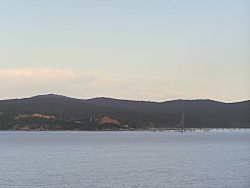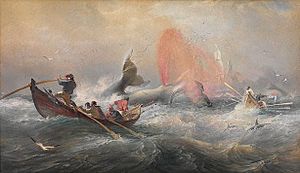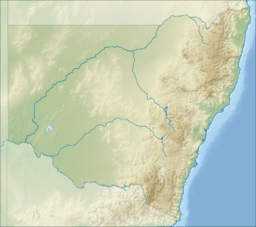Twofold Bay facts for kids
Quick facts for kids Twofold Bay |
|
|---|---|

Looking from Eden across Twofold Bay to wood chip supplies.
|
|
| Location | South Coast, New South Wales |
| Coordinates | 37°03′55″S 149°54′04″E / 37.06528°S 149.90111°E |
| Type | An open oceanic embayment |
| Primary inflows | Towamba River, Nullica River |
| Primary outflows | Tasman Sea, South Pacific Ocean |
| Catchment area | 11 km2 (4.2 sq mi) |
| Basin countries | Australia |
| Surface area | 30.7 km2 (11.9 sq mi) |
| Average depth | 10.9 m (36 ft) |
| Water volume | 334,559 megalitres (11,814.8×106 cu ft) |
| Frozen | never |
| Settlements | Eden |
Twofold Bay is a large bay that opens to the ocean. It is located on the South Coast of New South Wales, Australia.
The bay was named by George Bass. He called it "Twofold" because it has two main curves, like two big bites out of the land. The northern curve is known as Calle Calle Bay. The southern curve is called Nullica Bay.
Twofold Bay is also famous for the "Killers of Eden". These were killer whales that helped whalers find other whales. The most famous of these was Old Tom. You can see his skeleton at the local museum in Eden.
Contents
Discover Twofold Bay's Location and Features
Twofold Bay is found near the town of Eden. It is about 100 kilometers north of the border between Victoria and New South Wales. The bay gets its water from the Nullica River and Towamba River. Both of these rivers flow into Nullica Bay.
The area of land that drains into the bay is 11 square kilometers. The bay holds a lot of water, about 334,559 megalitres. Its surface area is 30.7 square kilometers, and it has an average depth of 10.9 meters. This makes Twofold Bay known as the third deepest natural harbor in the Southern Hemisphere.
Near North Head, there is a noticeable small island called Mewstone Rock. About 5 kilometers south of this island is Red Point. This point forms the southern edge of the bay. The town of Eden and the Port of Eden are located inside the bay. The historic town of Boydtown is to the west of the bay. It sits on Boydtown Beach, which stretches south from the Nullica River's mouth.
The waters around Twofold Bay are important. They are one of twelve special areas in Australia where southern right whales gather.
Explore the History of Twofold Bay
Indigenous History of Twofold Bay
The first people to live around Twofold Bay were Aboriginal people. They were from the Thaua clan, which is part of the Yuin nation.
European History and Early Exploration
The first European to visit Twofold Bay was George Bass. His travel journals show he saw the bay in 1797 or 1798. Bass was on a whaleboat trip to Bass Strait. He found shelter in the bay on his way back in February 1798. He named this safe spot "Snug Cove," and it is still known by that name today.
On October 7, 1798, Bass and Matthew Flinders left Port Jackson. They sailed in a ship called the Norfolk. Their goal was to find out if Van Diemen's Land (now Tasmania) was connected to mainland Australia. Another ship, the Nautilus, joined them. Two days later, they began to map Twofold Bay. Their map was very accurate and still used today. During this trip, Bass and Flinders also met the local Thaua people for the first time.
Many ship logs mention Twofold Bay. Ships often used it as a safe place from storms along the New South Wales coast. Some ships, like the George (1805) and the Mary (1821), were shipwrecked here.
Quarantine Bay is about 3 kilometers south of Eden. It got its name because a sailing ship with a smallpox outbreak found shelter there. Many people on board died and were buried in a shared grave on the shore.
In 1843, Benjamin Boyd bought land in Twofold Bay. He planned to transport cattle from the area. Soon after, Boyd started building the Seahorse Inn. This inn is next to what is now called Boydtown Beach. Boydtown Beach is on the western side of Twofold Bay. It is just south of the Nullica River's entrance. The Seahorse Inn is still used as a place for tourists to stay. Nearby are the old ruins of a church that Ben Boyd built. Boyd ran farming, whaling, and shipping businesses at Boydtown.
Twofold Bay in Popular Culture

Artist Oswald Brierly managed a whaling business in Boyd Town in the 1840s. While he was there, he created many paintings and sketches of the bay. He made more paintings of the area after he went back to Britain.
A poem by Thomas Fennell, RN, called Evening: A scene in Boyd Town, Twofold Bay, appeared in a New South Wales magazine in 1847. Twofold Bay is also the name and topic of a poem by E.J. Brady.
Will Lawson's book In Ben Boyd's day (1939) is set in the bay. Shirley Barrett's novel Rush Oh! (2015) also takes place here. It tells a made-up story about the family of whaler George Davidson in Eden.
The Eden Killer Whale Museum focuses on the history of whaling in the bay. It also highlights the special role killer whales played in that process.
Industry and Economic Activities in Twofold Bay
In the mid-2000s, two large wharves became important in the southeastern part of the bay.
The wharf furthest east serves a woodchip mill. Usually, two ships use this wharf each month. The forestry industry is very important to this region. The Eden woodchip mill is owned by South East Fibre Exports (SEFE). This company is part of Nippon Paper Industries, Japan's largest paper maker. The mill processes whole tree logs. It cannot process waste wood. The Eden chipmill was Australia's first chipmill. Conservationists have strongly opposed it for over forty years. Some conservationists believe that woodchipping harms many native animals and birds. They also say it greatly contributes to climate change.
The second wharf belongs to the Department of Defence. The Royal Australian Navy uses it to service its ships. Next to the woodchip mill is a naval munitions storage area. This wharf can be used for many purposes. Other ships, including cruise ships, can also dock here when naval ships are not using it.
Mussel farming takes place in the western part of the bay. It is located off the small piece of land between Cattle Bay and Quarantine Bay.



